The origin of the Burmese cat is shrouded in many mysteries, surrounded by numerous legends and legends. The descendants of Siamese and Persian cats for several centuries lived at Buddhist temples, protecting them not only from rodents, but also according to legends, they protected sacred places from evil spirits.
Today, the Burmese cat is one of the most popular breeds in the world. This calm, balanced, moderately active animal will be your faithful loving friend.
History, description and appearance
Burmese cat - a very ancient breed, known for several centuries. The truth earlier it was known only in Myanmar (Burma) and on the peninsula of Indochina. It was not until 1920 that an American millionaire, traveling through the Indochina regions, was fascinated by local cats living in the temples. He managed to acquire several kittens from the monks, whom he took to the USA. Only in 1925 the Burmese cat was widely spread in America, from there the breed spread over the ocean. After the Second World War in Europe there were only a few Burmese cats, it was a serious blow to the population of the breed. However, this has benefited the Burmese cats. Breeders managed not only to restore the breed, retaining all its qualities, but also significantly improve it.
This is far from the representatives of the feline tribe, so the weight of an adult cat does not exceed 6-7 kilograms, and cats 4-5. The head of the Burmese cat is wide and slightly rounded, the ears are slightly thickened at the base, medium length, planted far apart. The feet of the Burmese are strong, of medium length, the tail is thick and thick. About the paws is worth saying. If you plan, then when you buy a kitten, you need to pay close attention to their color. The front paws should have a white glove, which is bounded by a transverse line, but does not cross the angle of the wrist joint. Very good when symmetry is achieved. On the hind legs of the boots must cover the entire limb. This is considered a sign of high pedigree and then for your pet all doors will be opened at the most prestigious exhibitions. True, these kittens are quite expensive.
It is interesting!The eyes of Burmese cats can only be blue. At the moment there are several options for coloring Burmese cats: tortoiseshell, lilac, chocolate, blue, brown, cream and red. But the kittens are born white and only after reaching 6 months acquire their color.
Nature of the breed
At an early age, these are very curious, active and playful creatures. For full development they need a whole set of very different toys. Very good, if you can arrange a house where they can rest and relax. With age, their activity decreases. They become quiet and prefer quieter games. By nature they are non-conflicting and can get along with other animals, whether it's another cat or a dog. Natural nobility does not allow them to get involved in squabbles, they prefer to get rid of any conflict. Burmese cats are friendly and friendly, unlike their brethren who prefer to hide from guests, they often go out to meet them. But if it's too noisy around, then the cat will hide rather than show curiosity.
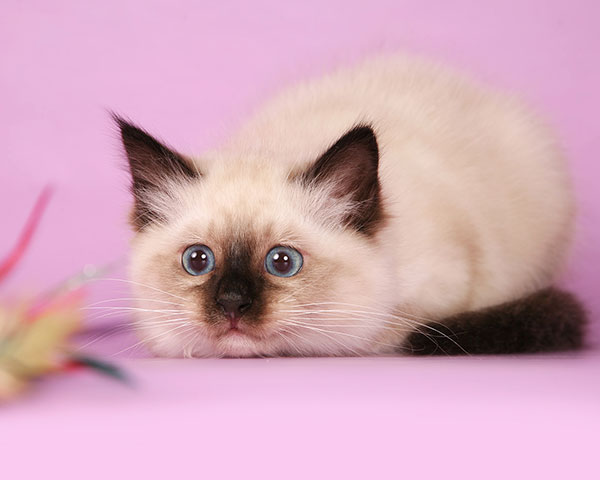
These are very smart animals and they can be taught to simple teams. They are easily accustomed to their place and to scratching. Despite the attachment to the owner, they tolerate the prolonged separation quite tolerantly. So if you go on vacation or business trip and give your pet an overexposure, then do not worry: the Burmese will honor your absence with honor. Among the features of the nature of this breed is to highlight unobtrusiveness. If the owner is not in the mood, then the Burmese cat will feel it and will not come up for a portion of affection or loud meow, it will wait for a more suitable moment.
If you shouted or pushed a cat, it will not revenge you, as many furry pets do, they are not vindictive. Almost all the "murks" are such a habit: then in the heat of gambling they can scratch and bite the owner. But this does not apply to intelligent Burmese cats, they can "control themselves" and never scratch their master.
It is interesting!The upbringing and restraint in these cats is in the blood, as a sure sign of a noble breed.
It is quite easy to take care of the fur of Burmese cats. Since they do not have an undercoat, it is enough to brush them out every two weeks with a special brush. During the seasonal moult it is necessary to comb out more often, about once a week. This is enough that your pet does not form collars. Ears must be cleaned every two weeks with a wet swab. If you decide, then you should be patient, Burmese cats do not like water procedures. Therefore, if you want the bathing to pass quickly and without hassle, then they need to be accustomed to this from an early age.
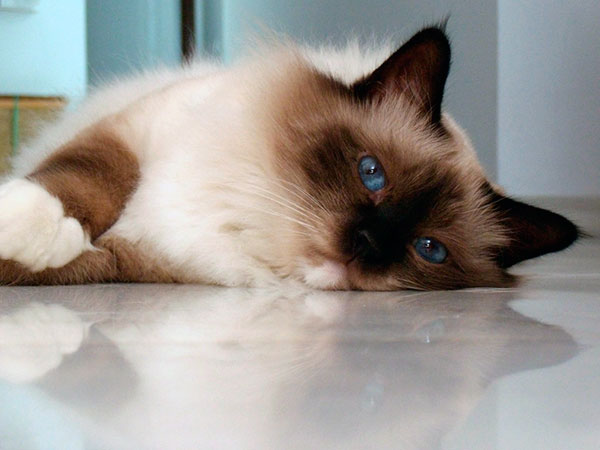
Burmese cats have strong enough health, genetic and hereditary diseases are rare. Regular visits to the veterinarian for preventive examination and routine vaccinations will provide your pet with a long and active life. However, in rare cases, Burmese cats still may suffer from hypertrophic cardiomyopathy, the symptoms of this disease usually appear at an early age. There is also a disease, such as the pathology of the vestibular apparatus. In addition, Burmese can suffer from corneal dermoids, this disease is successfully treated with a course of special antibiotics. The main thing is not to start a disease. The life span of Burmese cats is 12-14 years, but there are exceptions: the Burmese breeder is the record holder for longevity, this cat is called Catalina and she is 35 years old, at the moment this is the oldest cat in the world. Also these animals are fertile: in one litter can appear up to 10 kittens, the record was set by a cat that gave birth to 19 toddlers.
These are classic pets that are absolutely not adapted to life on the street, especially in the cold season. They are afraid of drafts, precipitation and low temperatures. They also do not know how to land properly because of the peculiarities of the vestibular apparatus. To provide walks in the fresh air, they can be released on the balcony with an open window, but it must necessarily be protected by a special net so that the cat does not fall out, because her natural curiosity can turn into a major trouble.
Food
These are real gourmets who like to eat very much and it's not about the amount of food, but in its quality. Of all the forages, they prefer meat natural food. It would be better if they give them beef, turkey or chicken. Some like boiled fish. Excludes any fatty meat and food, which contains salt, it can affect the condition of the kidneys and liver.
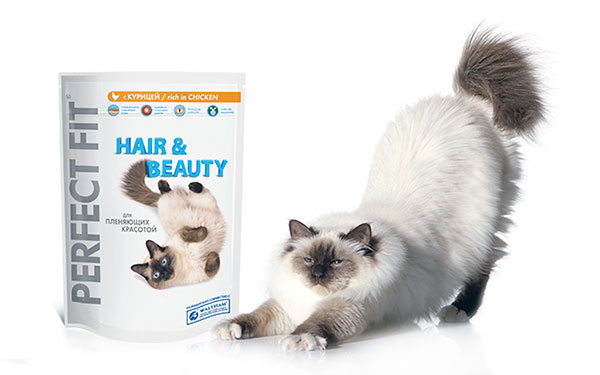
Important!You can not feed cats with spicy and smoked food, any products "off the table" are excluded. You can give and ready feed, but it is better if it is. Cheap feed can adversely affect the condition of the skin, coat and digestive tract.
Despite the fact that Burmese cats are very fond of eating, you can not worry about obesity: due to activity and good metabolism, it does not threaten them both at a young age and in adulthood.
Kittens should be fed chicken and beef low-fat minced meat and sour-milk products, this will help maintain the brightness of the fur in the future. The diet of adult cats should also contain sour-milk products, this is necessary for general health. For the full development of children they need to give 150 grams of food 4-5 times a day. Elderly and old cats are fed and as kittens, but the amount of food should be up to 200-250 grams 2 times a day. In any case, more than a Burmese cat does not eat, because even though they are gourmets, they are moderate in food.
Where to buy, price

Nurseries that specialize in breeding Burmese cats in our country - a rarity. Thoroughbred kittens are quite expensive, so a show-class animal can manage about 70,000 rubles, a breed class costs about 40,000, the pet class will be much cheaper, about 25,000 rubles. Burmese kitten without documents can be purchased for 10,000 rubles, as a rule this animal will be without a pedigree from unscheduled mating. It is not necessary to buy kittens from random persons on "bird markets" or on the Internet. In this case, the animal can be with a whole bunch of diseases, with a bad heredity, which will cause a lot of problems. When buying, pay attention to the general condition of the kitten: it must be strong and active, without festering eyes, with thick shiny hair.
If you decide to get a Burmese cat, you can be sure: you are acquiring a loyal friend for many years. These are very noble beings who will always respond to you with devotion and great cat love.
Cats are so wonderful creatures that sometimes they marvel at their grace and elegance. Two years ago I visited my well-known friend in the summer. She invited us to stay with her for a week. So I first met not only with beautiful Carpathians, but with an interesting breed of cats. A friend had a cat, which in appearance looked like a Siamese. I saw him at once strained, thought that aggressive. But the hozyatka explained to me that this breed is completely different and not aggressive at all. The young cat had a Burmese breed, as she called it "Burma." The cat's name was Kuzma. At first he was wary of me, and then realizing that I did not represent any danger, he began to jump to my knees and purr. He was very fond of when he was stroked and said how handsome he was. His character was very calm. He was not angry when something was not as required. I have never seen a protest about the diet. Although he loved fish to the point of unconsciousness, he never ate more than a serving bowl. Sometimes I even thought that the cat clearly understands what should be a portion of fish, cereal, soup, meat. But what he did not eat is bread. What has found such a sharp cat's nose in bread for me remains a mystery.
An interesting and very attractive was the coloring of the animal. It was a whitish-gray color with a navy "socks" on the legs, brown ears and the same nose. I want to note the cleverness of Kuzma. He was not allowed to climb the tables and even more so to take pioducts from the table. But if a piece of the meat was on the floor, he passes punishment. Therefore, the cat became the front paws on the leg of the table and began to push it, the table was loosened and something usually tasted on the floor and fell.
The cat, oddly enough, loved to play with the kids. And stroking their paws on the handles very carefully. True, the children did not differ in reciprocity, they were intersoval furry tail of the cat, so when the patience came to an end, Kuzma just ran away from the kids.
The wool of this cat was medium, but short it can not be called. The mistress combed her wool once a week with a special comb. The cat did not resist. Concerning the diseases, the mistress claimed that in all four years the cat had never been sick. The truth once managed to turn his paw and had to go to the vet. This cat was in itself, he always had "plans" different from the plans of the owners. When we went for a walk, he demonstratively laid on his bedding and he never walked with us, he later played his favorite balls when no one was home.
This breed I liked was a calm, intelligent and moving cat.
Some breeds of cats surprise with their unearthly beauty and splendor. One of the most beautiful representatives of the cat family is the Burmese cat. What exactly did the Burmese breed become famous for, and why is it considered sacred?
Origin of the sacred Burmese cat
An ancient legend says that the representatives of this breed were guards of Buddhist temples in Burma (modern Myanmar) from the beginning of time. Initially, the cats had white color, long hair and amber eyes. One of the wisest monks had a fluffy fellow named Sinh, who guarded the peace of his beloved master around the clock. One day, the robbers attacked the sacred temple, who wanted to steal a statue of the goddess with eyes of heavenly color. The goddess was poured out of pure gold. The monk rushed to protect the deity, but was killed by robbers in a sacred place. Then Sinh stood on the head of the murdered sage, and in the hall there was a piercing scream. After that his appearance was transformed: the cat's fur became golden, the tips of the paws are white, and the eyes are sky-blue. The robbers escaped, and the divine Sinh died after 7 days at the head of his master. After that, all the cat-guards of the temple were transformed in this way.
Most felinologists believe that the sacred Burma is a successful project of crossing French breeders of 2 breeds - Persian and Siamese. As for the time of origin, opinions were divided. Some believe that Burma in 1919 brought to Europe after a cruise around the world a descendant of the richest Vanderbilt family. Others adhere to the theory that the Burmese cat was represented by breeders only in 1925.
What does the Burmese breed of cats look like?
The sacred Burmese cat is an amazing creature with soft half-long hair and eyes the color of the frosty sky. What other features of the body structure of these unique cats?
- trunk small and squat;
- the head is round, the neck is short;
- the chin is developed, the jaw is powerful;
- the ears are not too large, at the base wide, tilted slightly forward;
- nose of medium length;
- the eyes of the round form are set far apart, the outer corners are slightly elevated,
- the color ranges from bright blue to turquoise;
- tail fluffy, straight;
- on the front of the muzzle, the fur is short, the whole body is long, with shortened legs;
- the main color is color-point. Officially, the world knows 4 types of this color: with chocolate, lilac, dark brown and blue marks. A distinctive feature of the color of Burmese cats - symmetrical "socks" on the front and hind legs of white.
The average weight of Burmese is 5-6 kg. Duration of life is relatively long - about 15 years. Their health is quite strong, genetic diseases are also not revealed. Therefore, with proper care the thoroughbred cat will live long enough.
Burmese cat: character
As for the character, the representatives of the sacred breed can be referred to a balanced, calm and intelligent animal. They are active in childhood, and when they grow up, they love peace and quiet, but they do not mind playing sometimes. A sacred birma is considered a peace-loving pet, therefore it can suffer some pranks from children or other relatives, but not to the detriment of oneself. Quite easy to bear Burmese cats separation from the owner. They will not follow you from room to room or demand increased attention. Their meow is quiet and melodic. They are curious, but not enthusiastic about the large crowd of people in a small room, so during the noisy parties they prefer to hide in the closet.
Important! Burma is quite capable of jumping out of a window or balcony, if something interests her, so it's better to prevent such an incident. As a rule, they unsuccessfully land on their paws and injure themselves.
These cats calmly treat other animals and small household members. They do not bite or scratch on trifles. Conflict situations are avoided, so they often escape from the "irritant", hiding in a secluded place.
They quickly accustom to the tray, they know their place and do not pretend to be "someone else's" territory. Communicative and friendly pets quickly master in the family and do not harm.

Kittens Burmese sacred cat with a pedigree and a full package of documents are expensive - from 200 to 1500 $. Source: Flickr (Frode_Finslo)
How to take care of a Burmese cat
From an early age it is necessary to accustom a pet to hygienic procedures. This breed has a long and thick coat, so it is necessary to follow it scrupulously:
Representatives of this breed prefer a balanced natural diet, but they also do not refuse ready-made dry food.
Burmese cats do not tolerate heat and do not like cold. The optimum temperature regime for keeping kittens and adults is 23-26 degrees Celsius.
Important! Do not forget that the cat diet should be 70% of meat products (turkey, rabbit, beef), 20% of complex carbohydrates (rice, carrots, greens), 10% of mono- and polyunsaturated fats and fatty acids Omega- 3 (olive or corn oil, tuna, quail eggs).
Breeding of Burma
Kittens Burmese sacred cat with a pedigree and a full package of documents are expensive - from 200 to 1500 $. At the big desire it is possible to find a kitten without documents at the price much more low (without the permission of nursery) - from 50 to 150 $.
The female of the sacred breed is knitted with a thoroughbred cat no more than 2-3 times during 2 years, so they are not massively bred.
Kittens from healthy parents are born strong, beautiful and playful. At one time the female produces up to 4 kittens. Care for them is expensive, so in the post-Soviet space there are very few nurseries involved in breeding this breed.
Merits and demerits of the Burmese breed
Many believe that the Burmese cat brings happiness and well-being to the house, and also protects the household from the evil eye.
Benefits of maintaining the Burmese sacred cat:
- very beautiful and affectionate animal;
- perfectly gets on with all the household members and fellows;
- smart and complaisant;
- not intrusive, likes to play;
- has good health and lives for a long time;
- quiet, does not meow on trifles.
Disadvantages:
- high cost for purebred kittens;
- increased attention to nutrition;
- constant care for long hair;
- maintaining a stable temperature in the room.
If you are ready to give such a pet your love and affection, then do not doubt that he will repay you the same. Burma relieves tension after a hard day's work, raises the mood, charges with positive energy all around itself. With such a pet you will never feel like a lonely person.
Related Videos
The majestic beauty of Burmese cats is fascinating. It is difficult to look away from the bottomless sapphire eyes, shiny long hair. The sacred Burma combines the external signs of the most famous breeds in the world - Persian and Siamese. From the Siamese, she inherited a crafty face and a specific coat coloring, from her ancestors from Persia - a calm character, a long fluffy coat.
History of the origin of Burmese cats
Burma, today renamed Myanmar, is the birthplace of these magical creatures. In ancient times Burmese temple cats were revered for the sacred beings.
According to one of the legends, in one of the Buddhist monasteries, an old monk Moon Xha, who had a cat Sinh, lived as a beautiful synagogue for the goddess Cun Huanze, who patronized the souls of Buddhist monks. Together with his congeners, like him, snow-white and yellow-eyed, Sinh guarded the temple and the statue of Cun Huanze there.
One day, the robbers attacked the sacred place, intending to capture Cun Huanze and desecrate the temple. Monks and animals began to protect the sacred walls, but the forces were unequal.
It seemed that all the defenders of the temple were defeated, killed by the bandits and brave Moon Ha. Suddenly his faithful friend Sinh jumped on the monk's head and hissed fiercely. His wool was shining with a golden glow, his yellow eyes turned into sky blue like the goddess, and the tips of his paws, sunk in the gray haunches of Moon Ha, became dazzling white, like holy gray hair.
Shocked robbers retreated, and the goddess was saved. A faithful cat remained standing on the gray hair of a beloved lord, and after seven days their souls were reunited in heaven. After the death of Sinha, all the cats in the temple acquired the same color and blue eyes, and their legs became white, as a sign of holiness and purity.
In Europe, cats of the sacred Burmese breed were imported in 1919, when Vanderbilt, an American millionaire, traveling in the East, purchased for a huge price several kittens, fascinated by their grace and beauty.

In 1925, Burmese were officially registered as a separate breed, but during the Second World War the genotype was almost lost - in Europe there were only two Burmese. Only in the fifties breeding work on the restoration of the breed continued. As a result of crossing Persians and Siamese, the Burmese cat (birman cat) has acquired the features of modern representatives of the unique breed.
Burmese breed: description, standard
Burmese cats are small animals. The weight of the male is only 5-6 kilograms, the cats are much smaller.
Sacred Burmese cat, breed standard:
- The body is massive, strong.
- The body is elongated, squat.
- Limbs are short, strong, massive.
- Paws large, roundish.
- The tail is of medium length, pubescent in the form of a sultan.
- The coat is long, smooth, shiny, wavy on the abdomen. Short fur on the muzzle immediately behind the cheeks becomes more magnificent, forming a frill. Undercoat is absent.
- Head broad, rounded
- The muzzle is rounded, with expressive cheeks. The line of the lower jaw forms a right angle with the line of the chin.
- The chin is strong, developed, slightly pointed, with the right bite.
- The ears are medium, set far apart, before the base there are flat areas with a small depression.
- The eyes are round, the outer corners are raised. Blue color.
- The nose is medium in length and width, with nostrils, which are located low on the lobe,

As for color, this is the main wealth of Burmese cats. The color range of wool varies from chocolate to blue. Acromelanic colors are widespread, when the legs, tail, ears and muzzle are darker, like in Siamese. Tortie and red are considered acceptable.
For the hind legs are characteristic "boots" with L-shaped spurs on the bottom, not reaching the hock. At the front legs - white "gloves", not in contact with the carpal joint. It is highly desirable that the white patches on the feet are symmetrical.
It is noteworthy that all kittens are born white, but with age they acquire this or that color. After reaching three months, snow-white spots appear on the paws. The intensity of color is achieved by a year and a half.
The most common are the following colors:
- blue point;
- force point;
- chocolate;
- with purple marks.
Description of the breed does not allow stripes on wool, marble pictures, monochromatic gray, red, black coat colors (even with a Siamese mask).
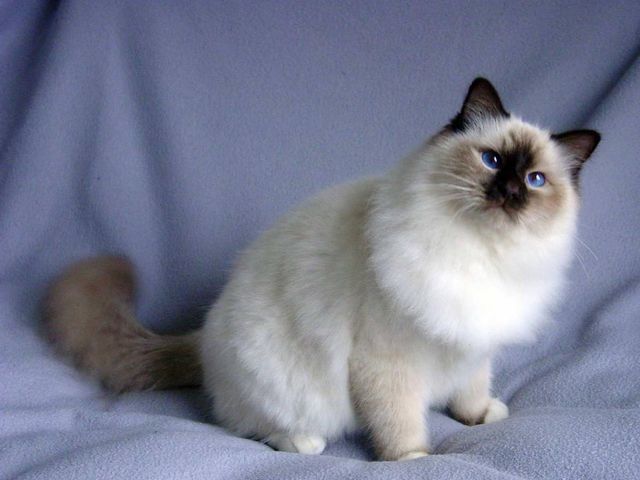
On the tummy the fur is lighter than on other areas of the hull, this is a sign of a true cat of Burmese sacred breed.
The nature and behavior of Burmese cats
The owners' testimonies indicate that the Burmese are so wonderful and kind, that there is no room for negative in the house where one of these remarkable creatures lives.
The animal does not tolerate noise and fuss, its whole being is subordinated to a calm, measured existence. It's just an ideal breed for families with young children, as it is famous for its friendly and peace-loving nature. With other animals, there will be no conflict, truly, a sacred and wisest creation!
Burmese sacred cats are inquisitive and playful, but in moderation, they will never impose their society and feel the master's mood very thinly. They have a fairly high intellect and understand the simplest commands. Love to sit on the arms and hug.
From the ancestors of the Siamese, they inherited a sense of their own dignity, from the Persians - phlegmatic. Therefore, Burmese need their own cozy corner, where they could retire from time to time - sometimes they prefer to stay alone to rest from the bustle. It is important that the basket or the house were not located on a hill - cats do not like climbing high.
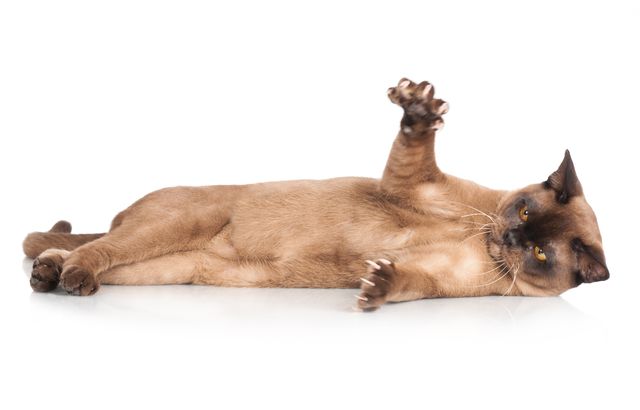
The voice of the Burmese is tender and melodious, you can not clearly refer this breed to the silent cats. Sometimes even you can hear from the owner of the fluffy blue-eyed favorite of the good-natured: "Here is the talker!" Indeed, the sacred cat cat not want to talk, tell people about their problems.
But it is perfectly brought up and never will make a mess in the house, it will not spoil owner's things. If the beauty is angry or angry, she will not show aggression, she will simply walk away proudly, without harboring malice.
Diseases Burmese
Temple cats are endowed with good health, but they have a number of hereditary diseases, which include:
- hypertrophic cardiomyopathy;
- pathology of the vestibular apparatus;
- corneal corneal dermoids;
Sometimes a cat may develop shortness of breath and cough, especially after a game that lasts a long time. Lethargy and passivity are also an occasion to show the animal to the vet.
To prevent diseases, timely vaccinations and de-worming are necessary.
In general, we can say that Burmese cats are healthy breeds, besides they are very prolific. A case is known when the Burmese Antigone gave birth to 19 kittens!
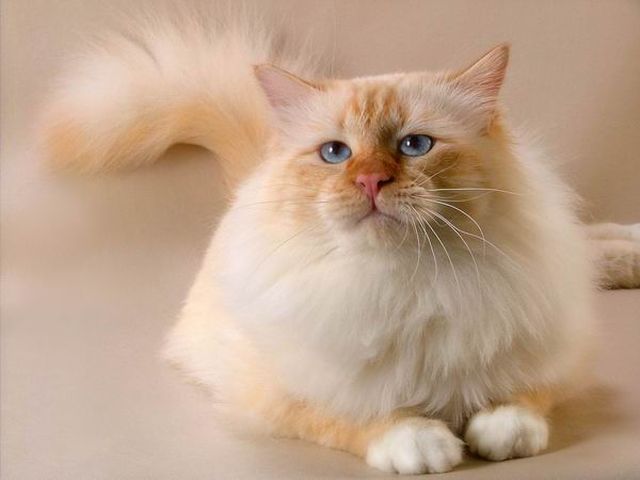
Sacred Burmese live 10-15 years, but with good care can live up to 20. It is noteworthy that the beautiful Australian Catalina is a long-liver - she turned 35 years old!
How to care for Burmese cats
The breed of cats is sacred Burmese belongs to purely domestic animals, completely not adapted to a street way of life. Innate intelligence simply does not allow them to withstand competition among domestic dwellers.
They are thermophilic, so the apartment should always be warm (at least 20 degrees), while airing the apartment is a prerequisite for keeping animals.
It should be noted that the kitten holy Burmese - a very curious creature and can make attempts to escape through a loosely closed door or window, so, as they say, you need eyes and eyes. Plus, animals do not know how to group, so falling for them is fraught with serious injuries.
It is not difficult to take care of Burma. Their rich fluffy wool has a feature - it does not slip into the coils due to the lack of undercoat and the elasticity of the outer hair. Combing with a special brush a couple of times in seven days will be quite enough.
The necessary hygiene procedures include: cleaning teeth, ears, daily wiping eyes with a damp cloth. Bathe cats as necessary, if their luxurious coat is dirty.
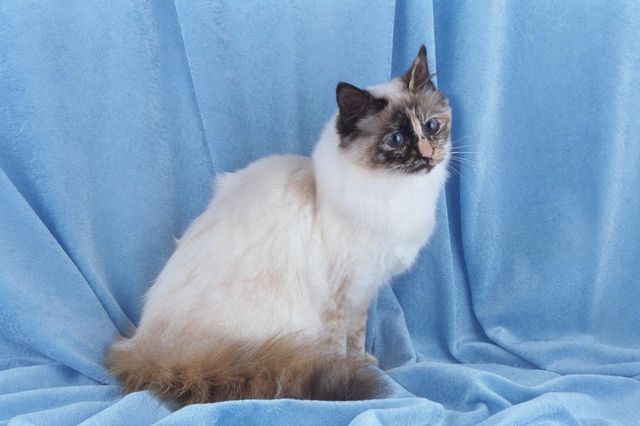
Burmese cats do not suffer from obesity, so there is no problem with food. They are not prone to overeating and clearly know the amount of food they need for their body. Burmese do not like industrial food, but they enjoy eating home-made food.
In this case, the ration of animals should be balanced and include the necessary amount of proteins, vitamins and macro elements. The cat should be fed twice, the kitten - 5 times a day.
Where to buy a Burmese cat
The breed of cats is sacred birma - expensive and very popular, so purchasing an animal is not an expensive pleasure. The cost of the Burmese babies starts from 20 thousand rubles. The higher the class of a kitten, the more expensive it is.
Acquiring an animal is better in nurseries, where breeders provide a veterinary passport with vaccinations, a pedigree, answer questions about feeding a kitten, talk about the nature of his mom and dad.
By ad on the Internet you can buy Burma and cheaper, but in this case, there is no guarantee of purebredness and health of the baby. Under the guise of a Burmese, they can sell both the half-breed and the ordinary mongrel baby.
These days these beauties with sapphire eyes are loved and widely distributed around the globe. They are peaceful and patient, not very chatty creatures, adapted exclusively to life at home under the care of the owners. The ancestors of Burmese cats were Persian and Siamese.
History
The emergence of this breed goes back far into the past and is shrouded in mystery, with it many myths and legends are associated. For many centuries these animals served as sacred keepers of Buddhist temples.
They protected them from rats, from enemies and from fires. However, the rest of the world met these luxurious creatures only in 1925 on the formal recognition of the breed in France.

The story of this event is connected with the love of the rich man from the US Vanderbilt to the country of Myanmar (also known as Burma), where he met these cats. A citizen of America was not stingy and paid an unprecedented price for a couple of fluffy kids.
However, a long journey to France was sustained by only one female. In 1919 her first kittens were born, and after 4 years the Burmese breed was registered under the name of the Sacred Burmese, thus denoting the outstanding history of the ancestors of these cats.

Before the Second World War, the representatives of this breed were very expensive in Europe, and after that they appeared to be under threat of extinction. Only a couple of individuals survived. As a result of the successful work of specialists in mating these animals, the Burmese breed received a new birth in Europe.
The number of these cats began to grow. In addition, the breeders were able to bring out new Burmese with the best exterior and healthier. In America, this breed was registered in 1966, in England - in 1967.
Legend
With the emergence of these cats an interesting legend is associated. Since ancient times in the Buddhist monasteries, along with the novices, fluffy cats have lived. In one of their temples there was a statue of a deity with sapphire eyes.

The commander of the cats-guards was the huge cat Sinh, the favorite creature of the most ancient monk Moon Ha. Once, on the sanctuary, robbers attempted to take possession of a gold statuette. The temple attendants fought bravely to defend the monastery, but the numerical superiority was on the side of the bandits. At the feet of the golden goddess, the elder died.
Then there was a terrible scream and the villains were numb in horror at the sight of a very large cat that arose over the body of the deceased elder. The eyes of the animal were sapphire, like a statuette. The fur was golden, the limbs white, like the graying hair of an elder.

Magical gaze led the robbers into confusion, and then the monks were able to defend their sanctuary. A faithful cat stayed there for a week at the site of the owner's death, and then went after him to another world.
Since then, all the fluffy inhabitants of the monastery have become the same fur color as Sinh, and their eyes have also become sapphire.
Exterior and colors
These animals are medium-sized and weigh around 5-6 kg. The constitution is strong, squat, the trunk is somewhat elongated. Paws large, powerful, not very long. The feet are impressive, rounded. The tail is not the longest, the character of the fur on it resembles a sultan.

The shape of the skull is enlarged, somewhat rounded. The muzzle is covered with short fur, and around it the coat is much longer. Ears like triangles with equal sides, oval ends. The chin is powerful, remarkably developed. The nose is straight, not very long.
The eyes are particularly interesting: widely spaced apart, rounded, the outer endings look slightly upward. The color of the eyes according to the standard of the breed should be exclusively in the heavenly scale.
Burmese cats have an upper-middle margin. On the abdomen the coat is thin and slightly wavy. Manishka is magnificent.

Siamese coloring of Burmese cats occurs only in 6 months. Kids are born completely white. Dark color over time acquire outstanding parts of the body: muzzle, paws and tail. Socks on the feet are usually white, on the hind legs end over the hock joint. The abdomen is always lighter than the withers.
Nowadays the following colors are most widely represented:
- tortoiseshell;
- lilac;
- brown;
- blue;
- color of cocoa;
- cream;
- fiery.
Habits and temperament
These cats are characteristically, on the one hand, curious and affectionate, like Siamese, and on the other, phlegmatic and imposing, like Persian. Particularly mobile only at a young age, but the love of the games of Burmese cats do not go until old age.

Although large individuals are more majestic and full of self-esteem, but to them more than once in a day comes the desire to frolic.
These cats are intelligent, educated, resourceful and tactful, not persistent. Birmanki patiently experience the absence of household members, but they are in great need of the owner and are bored by communication. Individuals of this breed are uninviting and non-aggressive. The voice is given infrequently and quietly, they have a singing, reminiscent of cooing.
These animals are sociable and are not afraid to approach new people. They can only be a little scary noise.

These cats are very intelligent, easy to train. Are able to understand elementary directions, can learn the sound of certain words and connect those with the right movements, things or people.
Burmese cats are able to bring small objects in the jaws, they like to play with people in the "aport". They react sensitively to the emotions of people, feel when you can ask for stroking, and in what cases it is better to stay away.
The sixth sense catches these cats, what is allowed for them, and what should be abstained from. So even in the heat of the game do not allow themselves too much. These pets never allow themselves to release claws in communion with the household.

These friendly and sociable animals do not seek to occupy the main positions, they do not fight for their territory. Thanks to this, they get on well with other pets in their house. Negative emotions are not expressed, they can establish relationships even with dogs. They sympathize with the kids, they like to play with them. It was noted that Burmese cats relieve stress in children from school lessons.
Physical state
Hereditary diseases in this breed did not occur. However, do not forget about the necessary vaccinations and visits to the veterinarian, to maintain the health of the pet for a long time. These animals have good health and prefer to live indoors. To hikes outside the home they do not stretch much.

They are troubled by drafts, cold and precipitation. However, in a warm, sunny day they will not refuse to lie on the grass.
When there is no possibility to drive a pet for walks, it is enough to ventilate the premises. Do not leave the cat with open windows without looking. Burmese cat can damage the legs, even kicking from the ground floor, since it does not differ in dexterity.

The street situation leads these cats into bewilderment, they are not accustomed to the struggle for existence, so they usually do not survive on the street.
Care and Nutrition
This breed does not have undercoat, thanks to this their big fur does not fall into the coils. For its excellent appearance, and a couple of combs a week with a steel brush with rounded tips. When molting, it is more regular to comb.
Once a month, the pet should be washed with a special shampoo for the tenderness of the fur and the obedience of the hairs. Twice a month it is necessary to wipe the ears of the pet with cotton wool or a damp napkin. These rituals should be taught to the cat from childhood so that it is not frightened or torn out.

Burmese cats know the measure of food, and they do not face excess weight. Even with surplus food in the bowl, the cat will take only the amount necessary for the organism, showing an amazing self-control. These animals are not choosy, however, packaged and soft feed they do not particularly favor. It is better to feed the pet with natural products that give good health for many years.
The standard of adults - food twice a day for 300 grams. appointment. Toddlers need to be fed in portions of 200 g five times a day. The menu should be dominated by protein. These cats are very fond of paired meat.
Cow meat and poultry will do. They love cats and boiled fish. To maintain the health of the fur and its special Siamese tone, you need to give the cat more sour-milk food.

Burmese cats are easy to master with comfort and convenience. If the infant is not accustomed to the pet in his infancy, he will always lie on the bed and the sofas, and it will not be able to drive it any more. So for those who do not like to sleep with cats, it is worthwhile to arrange a soft litter for the pet and accustom it to it.
You can make or buy a house for your cat from natural unpainted materials. Put it on the floor, as these cats do not like climbing without special need. Despite the long fur, Burmese love the warmth.

The ideal air temperature of the home is around 22 ° C. Heat these fuzzy do not like, so you should ventilate the room or disperse the air with special devices. Motor activity is very important in the life of these cats, so you need to organize a play area with toys and scratching.
Cats of this breed are excellent companions, both for singles and for large families. They are well adapted to the family circle and comfort, get used to the owner very much, because of this they should not be left for a long time.
These pussies are wonderful healers, which take away the stress of the working day, improve mood and infect the positive. Having endowed the pet with tender care, one can hope for his universal disposition and devotion. It must be remembered that individual individuals may not correspond to the above described features of the breed as a whole.
Popular nurseries of this breed:
- Russia - (here is your kennel);
- Belarus - (take the place);
- Ukraine - (apply).

